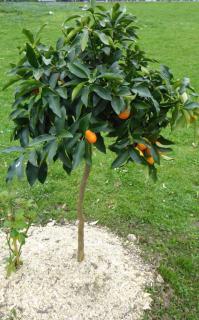

Kumquat is a citrus for which you can eat the skin together with the cute fruits.
Key Kumquat facts
Name – Fortunella japonica
Family – Rutaceae (Rue family)
Type – fruit shrub
Foliage – evergreen
Height – 6 to 13 feet (2 to 4 meters)
Exposure: full sun – Harvest: November to January
The planting, repotting, care, watering and pruning of kumquat are steps to take to grow a very nice plant.
Most often, kumquat is grown in pots as a beautiful houseplant. In mild climates, you can grow it outdoors and harvest fruits!
It is recommended to plant kumquat in a blend of soil mix preferably enriched with fertilizer.

Make this layer about 1 to 2 inches (3 to 4 cm) thick.
Anticipate repotting in a pot that is slightly larger than the previous every 2 or 3 years on average.
 Planting directly in the ground
Planting directly in the groundIt will only grow directly in the ground in Mediterranean-type climates or tropical climates.
Although it has been seen to resist temperatures as low as 17°F (-8°C) and even 14°F (-10°C), it must necessarily be planted under wind shelter and in full sun.
In which case, mix soil mix into your garden soil and ensure that your soil drains well.
If it doesn’t drain well, dig a hole that is slightly deeper, and layer gravel, rocks, sand or clay pebbles along the bottom.

To rebalance the silhouette of your kumquat, prune lightly in spring after the harvest, or just after repotting if it is a potted specimen.
You can also input citrus plant fertilizer during the entire growing phase.
In winter, if you fear particularly strong freezing and it is grown in a pot, bring it in a cool and well-lit room where it never freezes.
Although the kumquat can resist to freezing temperatures, its fruits will fall with the first frost.
Indoors, water regularly but not too much as soon as the soil is dry.
In winter, space the watering in order to let the soil dry up deep down before watering again.

Indeed, not only the flesh but also the skin of the kumquat is edible.
Indoors and in a pot, simply set it in a well-lit spot but avoid direct sunlight during the hottest hours.
In winter, it needs relatively lower temperatures and would not resist the heat inside a house or apartment. Ideally you’d find a luminous room for it where the temperature won’t drop below freezing. A greenhouse or lean-in would be perfect, for instance.
Regular adding of citrus plant fertilizer will greatly increase blooming and fruit formation of your kumquat.
My 20year old potted cumquat was neglected for 6 months by tenants and nearly dead when we returned to our home. We were able to save it, but now there is only one small branch (which I think comes from the grafted part) bearing 3 fruit and the rest of the tree has reverted to something else with thorns and a large leaf. Any suggestions?
Hi Michele, lucky you got back in time! What you’ll need to do is prune off the thorny growth that clearly has different leaves. It comes from the rootstock, which is usually a very different plant from the kumquat graft that’s above it. If you let those branches grow, you won’t get any interesting fruits off it. This is because the rootstock is chosen for the strength and resilience of its roots, and not at all for the quality of the fruits. It’s sure to be a citrus, but it might not even be a kumquat.
Another bad side effect of letting those rootstock shoots grow is that your grafted kumquat branch will actually die off! The roots will always favor their own shoots over grafted ones. You can try to identify the graft joint: anything below it will be rootstock shoots, and above it will be kumquat.
So to sum it all up, snip the rootstock shoots off as they appear. Since only one grafted branch survived, you’ll have to prune it so that it can branch out. If you wand to speed its growth, remove the three fruits, so that energy and sap is diverted to the leaf buds.